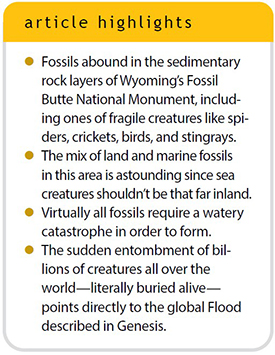 Beavers shouldn’t talk to humans. That obvious fact was highlighted in the movie adaptation of C. S. Lewis’ classic fantasy The Lion, the Witch, and the Wardrobe.1 Fairly early in the film, the four Pevensie siblings meet a beaver that talks to them. Oldest brother Peter says the beaver claims to know a certain faun. Oldest sister Susan replies, “He’s a beaver! He shouldn’t be saying anything!”
Beavers shouldn’t talk to humans. That obvious fact was highlighted in the movie adaptation of C. S. Lewis’ classic fantasy The Lion, the Witch, and the Wardrobe.1 Fairly early in the film, the four Pevensie siblings meet a beaver that talks to them. Oldest brother Peter says the beaver claims to know a certain faun. Oldest sister Susan replies, “He’s a beaver! He shouldn’t be saying anything!”
If something doesn’t make sense—like a talking beaver—that might indicate that a story is just fiction. And when the tale told is an evolutionary story, it doesn’t make sense because it’s just science fiction.
One example of such science fiction is the evolutionists’ efforts to explain the fossils found at Wyoming’s Fossil Butte National Monument, an astonishing fossil graveyard administered by the National Park Service. The unusual biodiversity of fossils doesn’t make sense if one assumes evolutionary stories. Rather, the physical evidence provides many provenance details for paleontologists to speculate and quarrel about.
The obvious “in your face” issue for any evolutionary paleontologist is this: These fossils memorialize clearly recognizable animals. But they shouldn’t be recognizable as anything! Animals with fragile body parts (like damselflies, crickets, and wolf spiders) are so delicate that when they die in the wild, they disintegrate or are eaten quickly and soon disappear.2,3
It’s also amazing that certain oceanic creatures, like stingrays, were buried in Wyoming so quickly and tightly that their body shapes didn’t disintegrate before fossilization.
Like sharks, sting rays have a skeleton composed of cartilage. Normally, cartilage is not preserved as a fossil as it disintegrates readily. The excellent skeletons of Xiphotrygon are good evidence of how well the shales of the Green River Formation preserve the fossils.4
Fossils are found as billions of dead things, buried in rock layers, laid down by water, all over the earth. All scientists agree that floods are the ideal conditions for forming fossils. When a plant or animal is rapidly and deeply buried in cement-rich sediment, the deep burial keeps the specimen from being totally destroyed by things like scavengers or wind or water currents, and the mineral cement hardens the material to preserve.…Dead things are broken down so fast [think vultures] that most fossils must have formed rapidly or they wouldn’t have formed [as recognizable fossils] at all.2

The multifarious mix of fossilized “graveyard” remains at the Fossil Butte National Monument consists of more oceanic animals than just stingrays and is jumbled together with terrestrial animals such as insects (dragonflies, damselflies, beetles, crickets, flies, bees, ants); various spiders; birds (frigatebirds, ground fowl, roller birds); finfish and shellfish (penaeid shrimp, ostracod shrimp, crayfish or lobsters, oceanic stingrays, sandfish, catfish, perches, paddlefish, shads, oceanic herrings, sardines); mammals (bats, squirrels, horses, tapirs); reptiles (alligators, anoles, other lizards, snakes, various turtles); amphibians (salamanders, frogs); gastropods (Turritella sea snails, freshwater snails); bivalves (mussels, clams); and more.3
Aside from their great preservation, how can so many oceanic animals like stingrays get buried with land animals inside the Rocky Mountains in Wyoming instead of along some ocean beach? “It’s an oceanic stingray! It shouldn’t be there.”
Only the worldwide Genesis Flood makes sense of these fossils. If there had been no global Flood, those animal fossils shouldn’t exist at all, much less be recognizable animals. So, just as a cairn of stones once served as a memorial monument (see Joshua 4:1–9), the fossils of Wyoming’s Fossil Butte National Monument now comprise a paleontological memorial to the fossil-forming Genesis Flood.
References
- Adamson, A., dir. The Lion, the Witch, and the Wardrobe. Los Angeles, CA: Walden Media, 2005.
- Parker, G. and M. Parker. 2007. The Fossil Book. Green Forest, AR: Master Books, 69.
- Thomas, B. New Fossil Book Won’t Showcase Obvious Catastrophe. Creation Science Update. Posted on ICR.org June 17, 2013; Hoesch, W. A. 2007. Lagerstätten! Acts & Facts. 36 (8): 14; Clarey, T. 2016. Fresh Water and Salt Water Don’t Mix. Acts & Facts. 45 (11): 9.
- Fossil Butte: The Geologic History of Fossil Butte National Monument and Fossil Basin. NPS Occasional Paper No. 3. National Park Service. Posted on npshistory. com, last updated March 1, 2005.
Top image: Blue spotted stingray
* Dr. Johnson is Associate Professor of Apologetics and Chief Academic Officer at the Institute for Creation Research.

















